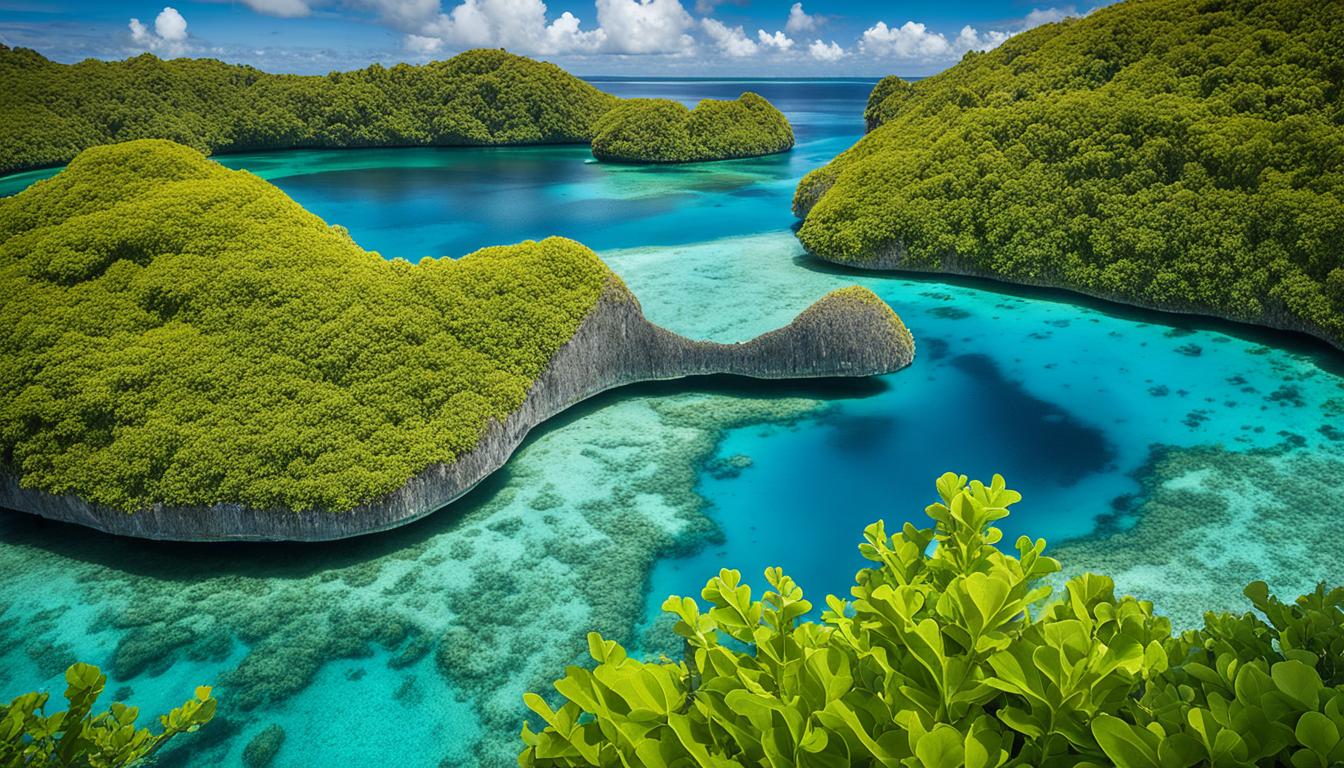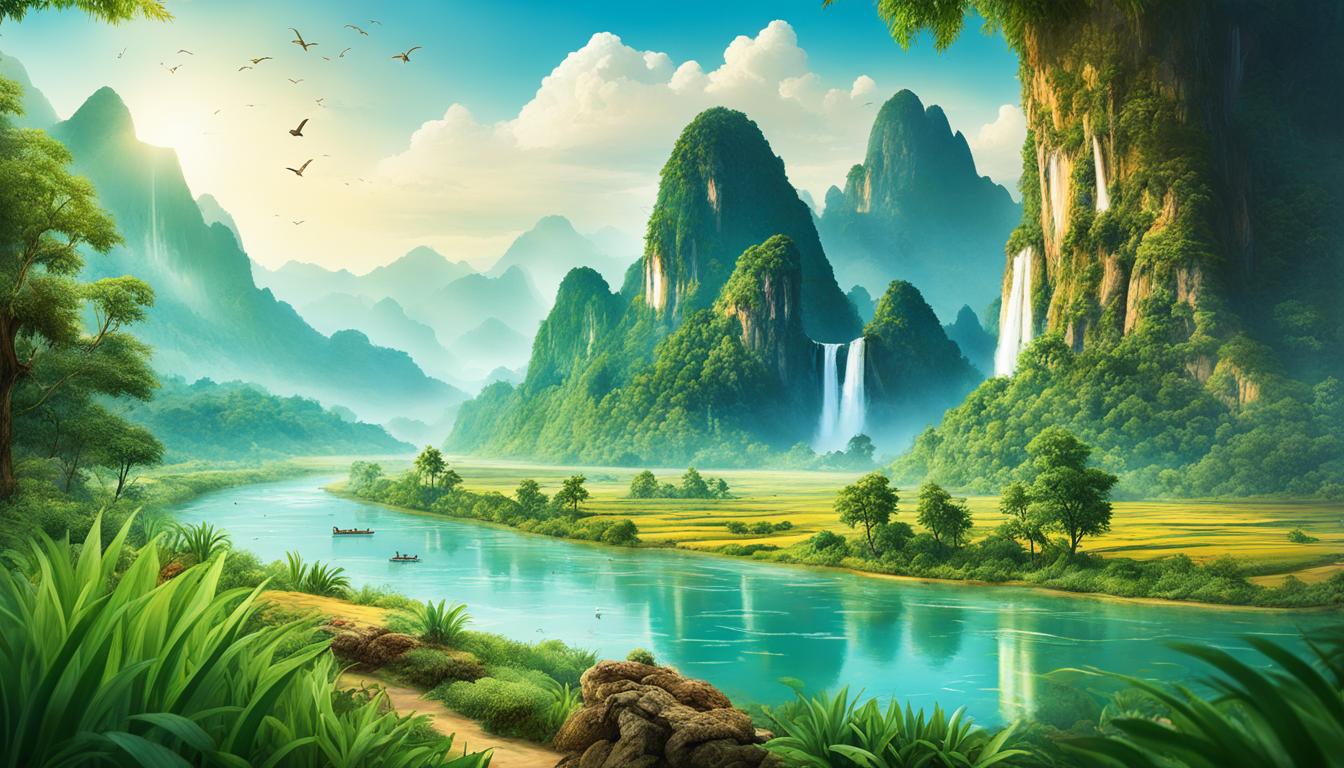Pakistan Sacred Natural Sites and Biodiversity
Did you know that Pakistan is home to over 131 identified sacred natural sites, encompassing a staggering 25,000 square kilometers of untouched beauty? These sites hold immense ecological importance, cultural heritage, and biodiversity, making them vital for nature conservation and sustainable development.
Key Takeaways:
- Pakistan boasts over 131 sacred natural sites, covering 25,000 square kilometers.
- These sites play a crucial role in preserving biodiversity and cultural heritage.
- Protecting these sites promotes sustainable development and environmental conservation.
- Traditional knowledge is invaluable in understanding and managing these sacred natural sites.
- Pakistan’s dedication to safeguarding these treasures ensures a deeper connection with nature.
The Importance of Sacred Natural Sites
Sacred natural sites hold great significance in the realm of biodiversity conservation and cultural heritage preservation. These sites serve as critical habitats for a diverse array of unique species, contributing to the protection and maintenance of biodiversity. Furthermore, they are invaluable treasures of cultural heritage, representing the deep spiritual and historical connections of communities with their natural surroundings.
By recognizing the ecological value and cultural significance of sacred natural sites, the government of Pakistan has taken significant steps towards their preservation and conservation. These sites, such as Deosai National Park and Kaghan Valley National Park, have been granted protected status, highlighting their crucial role in sustaining the delicate balance of ecosystems and safeguarding biological diversity.
Through their protection, sacred natural sites contribute to the overall environmental protection and sustainable development of Pakistan. They play a pivotal role in the maintenance of ecosystem services, such as water filtration, soil stabilization, and carbon sequestration. Additionally, they serve as outdoor classrooms, providing opportunities for research, education, and environmental awareness.
These sites also support the livelihoods of local communities, as they are often associated with traditional practices, ceremonies, and cultural events. They provide a platform for intergenerational knowledge transfer, preserving the wisdom and customs of indigenous communities.
Biodiversity Conservation
The conservation of sacred natural sites directly contributes to the protection of biodiversity. These sites are often home to rare and endangered species, representing significant components of global and regional biodiversity. By preserving the ecosystems of these sites, we ensure the survival of these species and the integrity of their habitats.
“Sacred natural sites are sanctuaries for diverse species, fostering the coexistence of flora and fauna in harmonious balance.” – Local Conservationist
Cultural Heritage
The cultural heritage associated with sacred natural sites is rich and multifaceted. These sites embody the traditions, beliefs, and stories of indigenous communities, passed down through generations. They serve as living cultural landscapes, reflecting the historical, spiritual, and social evolution of societies over time. The preservation of sacred natural sites is, therefore, crucial for the safeguarding of intangible cultural heritage.
“Sacred natural sites are woven into the tapestry of our identities and provide a sense of belonging and reverence for the natural world.” – Cultural Anthropologist
Environmental Protection
By protecting sacred natural sites, we contribute to the overall environmental protection. These sites act as natural buffers against environmental degradation, mitigating the impacts of climate change, habitat loss, and pollution. Their conservation fosters the resilience and sustainability of ecosystems, ensuring their ability to provide essential ecosystem services.
- Soil stabilization
- Water filtration
- Carbon sequestration
Furthermore, sacred natural sites serve as nature-based solutions, enhancing overall landscape resilience and supporting climate change adaptation measures.
| Key Benefits of Protecting Sacred Natural Sites | Biodiversity Conservation | Cultural Heritage | Environmental Protection |
|---|---|---|---|
| Preservation of unique species and habitats | Protection of traditional knowledge and customs | Mitigation of climate change impacts | |
| Support for ecosystem services | Inter-generational knowledge transfer | Enhancement of landscape resilience | |
| Environmental education and awareness | Safeguarding of intangible cultural heritage | Nature-based solutions for adaptation |
By recognizing and prioritizing the protection and conservation of sacred natural sites, Pakistan showcases its commitment to the sustainable management of its natural and cultural resources. Through collaborative efforts between governments, local communities, and environmental organizations, these sites can continue to thrive and contribute to a healthy and harmonious coexistence between humans and nature.
Deosai National Park
Deosai National Park, known as the “Land of the Giants,” is an alpine plateau located in Pakistan. This breathtaking park is home to a diverse range of wildlife, including the critically endangered Himalayan brown bear, Tibetan wolf, Himalayan ibex, Tibetan red fox, and golden marmots. Its remarkable biodiversity makes it a hotspot for nature enthusiasts and researchers alike.
The park covers an area of approximately 3,000 square kilometers, offering visitors an expansive landscape to explore and discover. The rugged terrain and high altitude provide a unique habitat for these magnificent creatures. Deosai National Park is renowned for its picturesque scenery, which includes vast meadows, crystal-clear lakes, and snow-capped peaks.

The rich biodiversity of Deosai National Park has earned it recognition and protection from the government of Pakistan. The park was granted protected status to safeguard its remarkable flora and fauna for future generations. In addition, it was nominated for UNESCO World Heritage status in 2016, emphasizing its global significance and value.
Visitors to Deosai National Park can immerse themselves in the natural surroundings and witness the extraordinary wildlife that thrives in this unique ecosystem. The chance to spot the majestic Himalayan brown bear, with its distinctive features and immense size, is a highlight for wildlife enthusiasts. The Tibetan wolf, known for its elusive nature, can occasionally be spotted in the park. Other notable species include the Himalayan ibex, known for its impressive curved horns, the Tibetan red fox, with its vibrant fur, and the golden marmots, adding a touch of charm to the landscape.
Flora and Fauna of Deosai National Park
The biological richness of Deosai National Park is not limited to its iconic mammals. The park is home to a diverse range of plant species, including alpine meadows that burst into a riot of colors during the flowering season. Visitors can witness the vibrant blooms of wildflowers, creating a breathtaking display against the backdrop of the pristine landscape.
A comprehensive list of the flora and fauna found in Deosai National Park is presented in the table below:
| Flora | Fauna |
|---|---|
| 1. Alpine meadows 2. Juniper trees 3. Himalayan herbs and shrubs |
1. Himalayan brown bear 2. Tibetan wolf 3. Himalayan ibex 4. Tibetan red fox 5. Golden marmots 6. Numerous bird species |
The diverse range of flora and fauna found in Deosai National Park highlights its ecological importance and the need for its continued preservation. The park offers a glimpse into Pakistan’s natural treasures and provides a sanctuary for these remarkable species.
Kaghan Valley National Park
Kaghan Valley National Park is a picturesque area nestled in the northwest of Pakistan. This enchanting valley is renowned for its fairy tale-like landscapes, offering visitors breathtaking views of soaring mountain peaks, lush meadows, and crystal-clear alpine lakes. One of the park’s iconic attractions is the famous Lake Saiful Muluk, which holds a special place in local folklore.
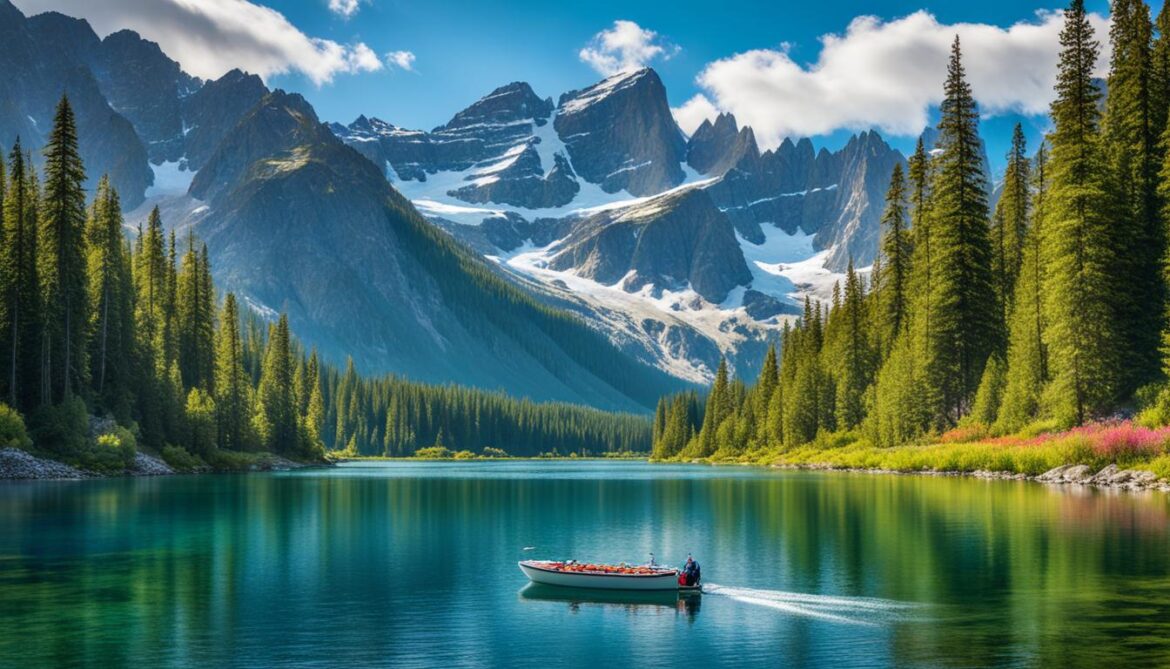
The mesmerizing Lake Saiful Muluk is a true gem of Kaghan Valley National Park. Situated at an altitude of 10,578 feet, this serene lake captivates visitors with its emerald-green waters, reflecting the surrounding majestic mountains. It is said that the lake is named after a Persian prince who fell in love with a fairy princess. The local legend adds a touch of magic and romance to this already enchanting destination.
The park’s mountain scenery is simply awe-inspiring. Towering peaks, such as Malika Parbat and Makra Peak, provide a majestic backdrop to the valley. The lush meadows, carpeted with vibrant wildflowers, offer a peaceful retreat amidst the rugged terrain. Exploring the park’s trails allows visitors to immerse themselves in the beauty of nature and experience a sense of tranquility.
“Kaghan Valley National Park is a haven for nature enthusiasts and adventure seekers alike.”
The park’s alpine lakes are another highlight of its natural wonders. These pristine bodies of water, including Dudipatsar Lake and Lulusar Lake, shimmer like precious gems against the backdrop of the surrounding peaks. The tranquility of these lakes provides an opportunity for visitors to connect with nature and find solace in the peaceful surroundings.
Kaghan Valley National Park also offers stargazers an unparalleled experience. With minimal light pollution, the clear night skies reveal a mesmerizing display of stars, allowing visitors to witness the wonders of the universe in all its glory. Camping under a canopy of stars is a popular activity in the park, creating unforgettable memories.
Hiking Trails in Kaghan Valley National Park
The park boasts a network of hiking trails that cater to different levels of experience and fitness. From leisurely walks in the meadows to challenging treks to high-altitude passes, there is something for everyone. Hiking in the park provides an opportunity to explore the diverse flora and fauna, breathe in the fresh mountain air, and witness the raw beauty of the landscape.
Some popular hiking trails in Kaghan Valley National Park include:
- Saiful Muluk Fairy Meadow Trek: A moderate trek that takes hikers through lush meadows, offering majestic views of Lake Saiful Muluk.
- Dudipatsar Lake Trek: A challenging trek that leads to the mesmerizing Dudipatsar Lake, surrounded by snow-capped peaks.
- Lalazar and Lake Lulusar Trek: A scenic trek that combines the beauty of the alpine meadows of Lalazar with the breathtaking sight of the turquoise Lake Lulusar.
Alpine Lakes in Kaghan Valley National Park
| Alpine Lake | Altitude (feet) | Features |
|---|---|---|
| Lake Saiful Muluk | 10,578 | Emerald-green waters, local legend |
| Dudipatsar Lake | 13,590 | Mesmerizing beauty, surrounded by snow-capped peaks |
| Lulusar Lake | 11,190 | Turquoise waters, captivating views |
Visiting Kaghan Valley National Park is like stepping into a fairy tale. With its stunning mountain scenery, enchanting lakes, and serene ambiance, it offers a truly magical experience. Whether you are seeking adventure, tranquility, or simply a chance to connect with nature, this national park has it all.
Makran Coastal Highway
The Makran Coastal Highway is a scenic drive along Pakistan’s Arabian Sea coast. This picturesque route offers breathtaking views of the coastline and is considered a major infrastructural achievement. One of the highlights of the Makran Coastal Highway is the famous Buzi Pass in Hingol National Park, which is known for its unique natural rock formations.
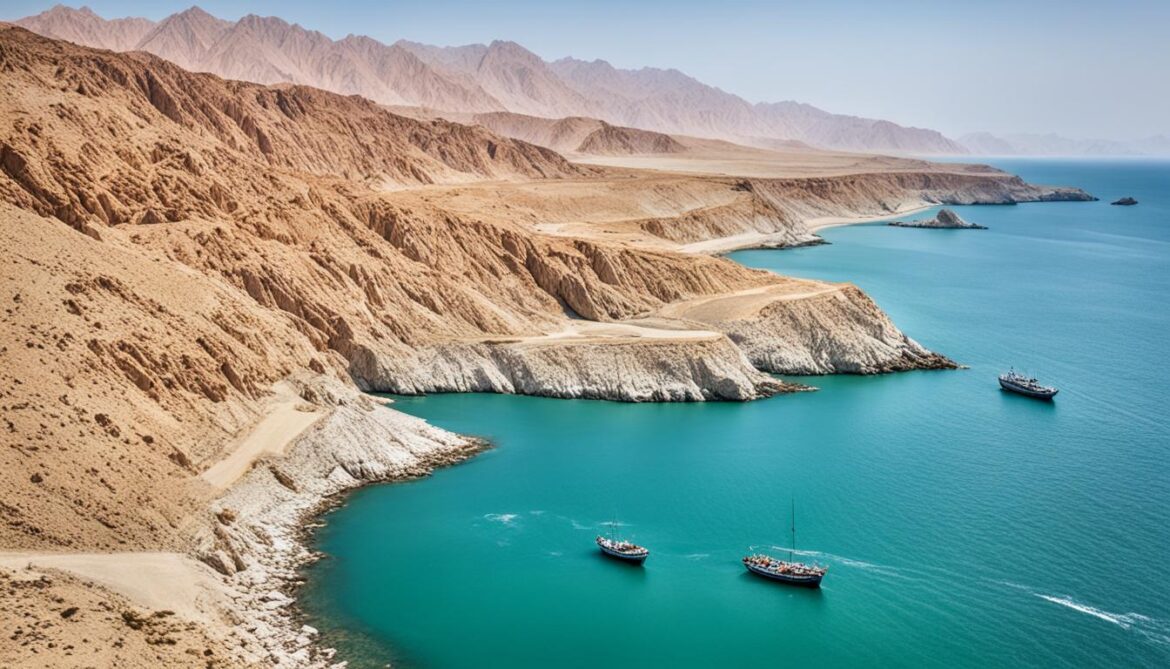
Exploring the Buzi Pass in Hingol National Park is like stepping into a world of natural wonders. The pass is adorned with fascinating rock formations, including the awe-inspiring “Lion of Balochistan.” These natural sculptures are a testament to the immense geological forces that have shaped the region over millions of years.
Driving along the Makran Coastal Highway, visitors can witness the raw beauty of the Arabian Sea coast while marveling at the striking natural rock formations in Hingol National Park. The combination of the pristine coastline and the unique geological features makes this highway a must-visit destination for nature enthusiasts and adventure seekers.
The Lion of Balochistan: A Natural Rock Formation
The “Lion of Balochistan” is a remarkable rock formation that resembles a majestic lion overlooking the landscape. This stunning creation of nature captures the imagination of all who encounter it. The Lion of Balochistan stands as a testament to the incredible power and beauty of natural forces.
| Features | Description |
|---|---|
| Location | Buzi Pass, Hingol National Park |
| Appearance | Resembles a lion overlooking the landscape |
| Geological Formation | Erosion and weathering over millions of years |
| Significance | Symbolizes the unique natural beauty of Hingol National Park |
The Lion of Balochistan is a perfect example of the extraordinary natural wonders that can be found along the Makran Coastal Highway. Its presence enriches the already spectacular scenery, leaving visitors in awe of the magnificence of nature.
Hunza Valley
The breathtaking Hunza Valley, nestled in the picturesque Hindu Kush Mountains of Gilgit-Baltistan, is a paradise for nature enthusiasts and wildlife lovers. With its majestic icy peaks and stunning landscapes, the valley is a haven for biodiversity, hosting a diverse array of species that call this region home.
One of the most notable species found in the Hunza Valley is the elusive snow leopard. These magnificent big cats, with their beautiful spotted fur, roam the steep cliffs and rocky slopes, perfectly adapted to their rugged habitat. The valley is also home to other iconic species, including the agile markhors and ibexes, which gracefully navigate the treacherous mountain terrain.
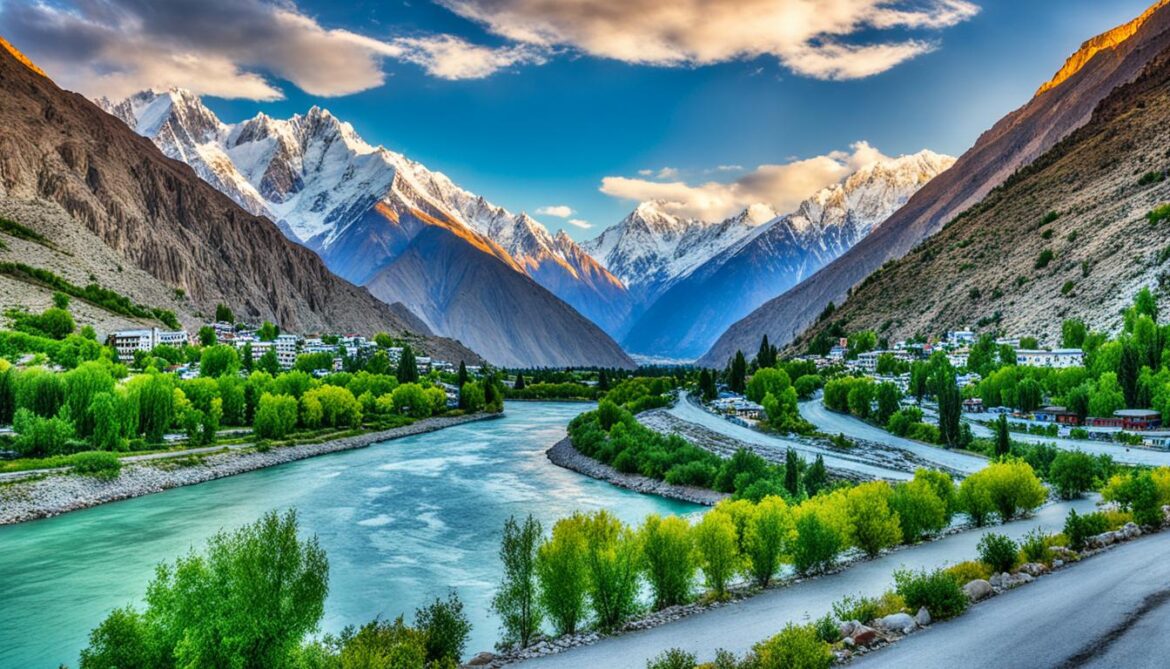
The Hunza Valley is not only known for its majestic mountains and unique wildlife, but also for its fascinating history and vibrant culture. The town of Hunza, situated on the banks of the Hunza River, offers visitors a chance to immerse themselves in the rich heritage of the region and explore the ancient forts and settlements that dot the landscape.
The Hunza Valley also hosts a variety of other fascinating species, including the red-striped foxes. These beautiful creatures, with their fiery red fur and sleek physique, can be spotted darting through the valleys and meadows, adding to the region’s natural charm and allure.
Exploring the Hunza Valley is a remarkable experience, offering visitors unparalleled opportunities to witness the wonders of nature and immerse themselves in the breathtaking beauty of the Hindu Kush Mountains. Whether it’s trekking through the rugged landscapes, observing the majestic snow leopards in their natural habitat, or simply taking in the awe-inspiring views, the Hunza Valley never fails to leave a lasting impression.
Highlights of the Hunza Valley:
- Stunning landscapes of the Hindu Kush Mountains
- Rich biodiversity, including snow leopards, markhors, ibexes, and red-striped foxes
- Fascinating history and vibrant culture in the town of Hunza
- Ancient forts and settlements showcasing the region’s heritage
| Species | Appearance | Habitat |
|---|---|---|
| Snow Leopards | Spotted fur and agile build | Steep cliffs and rocky slopes |
| Markhors | Majestic spiral horns | Treacherous mountain terrain |
| Ibexes | Curved horns and surefootedness | Mountainous regions and rocky outcrops |
| Red-Striped Foxes | Fiery red fur and sleek build | Valleys and meadows |
Hingol National Park
Hingol National Park, the largest national park in Pakistan, is a haven for nature enthusiasts and geology enthusiasts alike. This magnificent park is renowned for its diverse wildlife, including the majestic Sindh leopards, graceful chinkaras, fearless honey badgers, and elusive Indian pangolins. These incredible creatures roam freely in their natural habitat, creating a truly captivating experience for visitors.
However, what truly sets Hingol National Park apart is its cluster of active mud volcanoes. These extraordinary geological features add to the park’s allure, offering a unique and awe-inspiring sight. Witnessing the bubbling mud and the occasional eruption is a surreal and unforgettable experience that highlights the park’s geological significance.
Exploring Hingol National Park allows visitors to immerse themselves in the beauty of nature and marvel at its wonders. Surrounded by breathtaking vistas and rich biodiversity, every step in this park is an opportunity to connect with the natural world and gain a deeper appreciation for its splendor.

Baltoro Glacier National Park
Baltoro Glacier National Park, nestled in the eastern Karakoram Range, is a stunning natural wonder that captivates visitors with its breathtaking scenery and towering peaks. This national park is renowned for its mesmerizing valley glacier and is home to some of the world’s highest peaks, including K2, Broad Peak, and the Gasherbrum Peaks.
Stretching across vast expanses, the Karakoram glaciers play a vital role in providing water to the northern regions of Pakistan. The meltwater from these glaciers is a precious resource that sustains local ecosystems and supports the livelihoods of nearby communities.
As visitors explore Baltoro Glacier National Park, they are greeted with panoramic views of majestic mountains, shimmering ice formations, and cascading waterfalls. The park’s diverse landscape offers a haven for outdoor enthusiasts, from challenging treks for seasoned mountaineers to scenic trails for leisurely hikers.
“Baltoro Glacier National Park is a testament to the awe-inspiring power and beauty of nature. Its towering peaks and icy landscapes leave a lasting impression on all who have the privilege of visiting.”
Adventurers can embark on expeditions to conquer the challenging summits of K2, Broad Peak, and the Gasherbrum Peaks, pushing the limits of human achievement in the face of nature’s grandeur. These peaks, shrouded in mythical allure, have long captured the imagination of mountaineers from around the world.
As visitors traverse the glaciers and pristine valleys of Baltoro Glacier National Park, they may encounter rare wildlife species that have adapted to the harsh mountain environment. From the elusive snow leopard to the majestic ibex and the nimble red-striped fox, the park provides a habitat for a diverse array of creatures.
The glaciers of Baltoro Glacier National Park are not only a symbol of awe-inspiring natural beauty but also serve as a crucial lifeline for the region. Their meltwater sustains the communities downstream, irrigating fields and providing water for domestic use, agriculture, and hydropower generation.
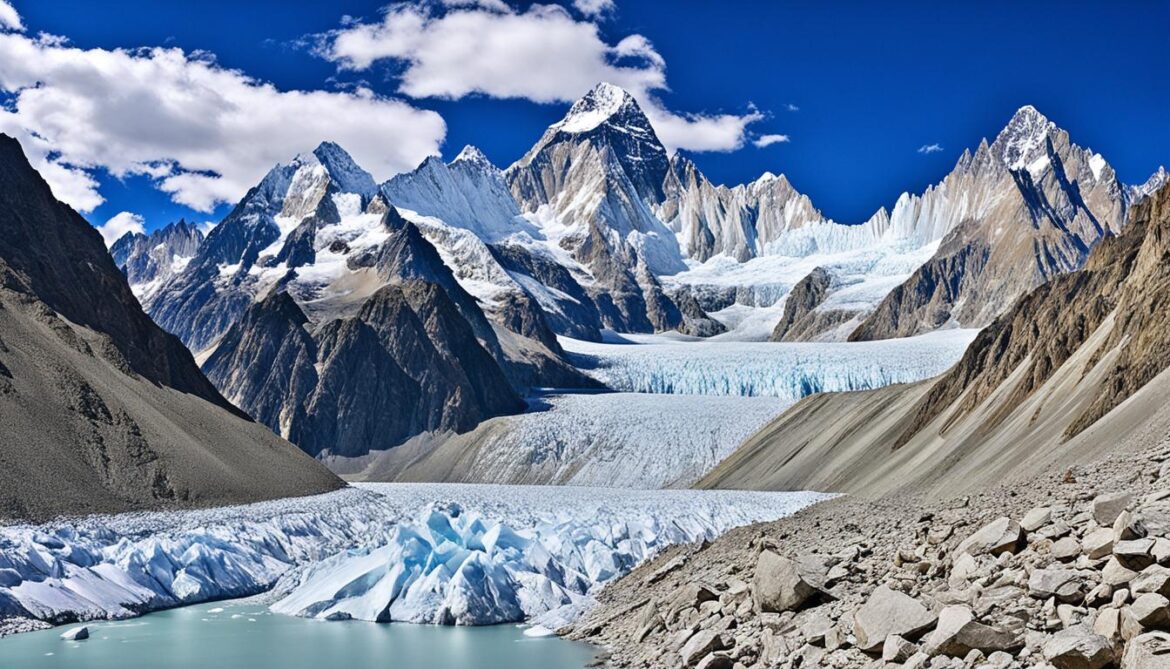
Glacier Comparison
| Glacier | Location | Peak | Meltwater Importance |
|---|---|---|---|
| Baltoro Glacier | Karakoram Range | K2 | Crucial water source for northern Pakistan |
| Gilkey Glacier | Denali National Park, Alaska | Denali (Mount McKinley) | Supplies water to rivers and lakes in the region |
| Perito Moreno Glacier | Los Glaciares National Park, Argentina | Cerro Fitz Roy | Feeds into Lake Argentino, maintaining its water levels |
Neelum Valley National Park
Neelum Valley National Park, nestled in the picturesque Azad Kashmir region of Pakistan, is a natural wonderland that showcases the breathtaking beauty of the country’s landscape. This bow-shaped valley is surrounded by majestic mountain peaks and adorned with verdant forests, creating a paradise for nature enthusiasts and adventure seekers.
The verdant forest of Neelum Valley National Park is a sight to behold. The lush greenery, composed of a diverse range of trees and plants, creates a tranquil and refreshing ambiance. As you wander through the park, you’ll be greeted by the melodious songs of birds echoing through the trees, adding to the park’s serene atmosphere.
The mountain peaks that embrace Neelum Valley National Park are truly awe-inspiring. These towering giants, clothed in glistening snow during the winter months, provide a magnificent backdrop. Whether you’re an avid trekker or simply seeking a peaceful retreat, the mountain trails offer a memorable experience, allowing you to immerse yourself in the beauty and tranquility of nature.
The park is also adorned with breathtaking waterfalls that cascade down the mountainsides, filling the air with the refreshing sound of flowing water. These natural wonders provide a perfect spot to pause, relax, and marvel at the raw power and beauty of nature.
One of the park’s highlights is the small hilltop village of Arang Kel, often referred to as the pearl of Neelum Valley. Perched atop a hill, Arang Kel offers a panoramic view of the surrounding mountains, waterfalls, and hiking paths. The village is a haven for travelers looking to connect with nature, offering a peaceful escape from the hustle and bustle of everyday life.
Explore the Beauty of Neelum Valley National Park
Neelum Valley National Park invites visitors to embark on a journey of discovery and exploration. Hike through the verdant forests, witness the grandeur of the mountain peaks, and revel in the beauty of the cascading waterfalls. Take a moment to bask in the tranquility and serenity of this natural paradise.
“Neelum Valley National Park is a hidden gem, offering a captivating blend of pristine forests, majestic mountain peaks, and enchanting waterfalls. It is a testament to the breathtaking beauty of Pakistan’s natural landscapes.”
Neelum Valley National Park Overview
| Location | Azad Kashmir, Pakistan |
|---|---|
| Key Features | Verdant Forest, Mountain Peaks, Waterfalls |
| Main Attraction | Arang Kel |
| Hiking Trails | Varied difficulty levels |
| Wildlife | Various bird species, mammals, and insects |
Attabad Lake
Attabad Lake, nestled in the picturesque Hunza Valley, is a true gem of Pakistan. With its vibrant turquoise waters, the lake offers a stunning spectacle that is sure to captivate any visitor. But Attabad Lake’s beauty goes beyond its mesmerizing color.
In 2010, the lake was formed by a massive landslide that originated from the nearby mountains. This natural disaster flooded the surrounding towns and villages and tragically blocked the flow of the Hunza River. What was once a devastating event has now transformed into a captivating sight that attracts tourists from all over the world.
Today, Attabad Lake has become a popular destination for boat tours, allowing visitors to explore its turquoise waters and take in the breathtaking views of the surrounding mountains. Whether you’re cruising along the lake or simply relaxing on its shores, the tranquil atmosphere and stunning scenery will leave you in awe.
Don’t miss the opportunity to visit this natural wonder during your trip to Pakistan. Experience the beauty of Attabad Lake and immerse yourself in the splendor of the Hunza Valley.
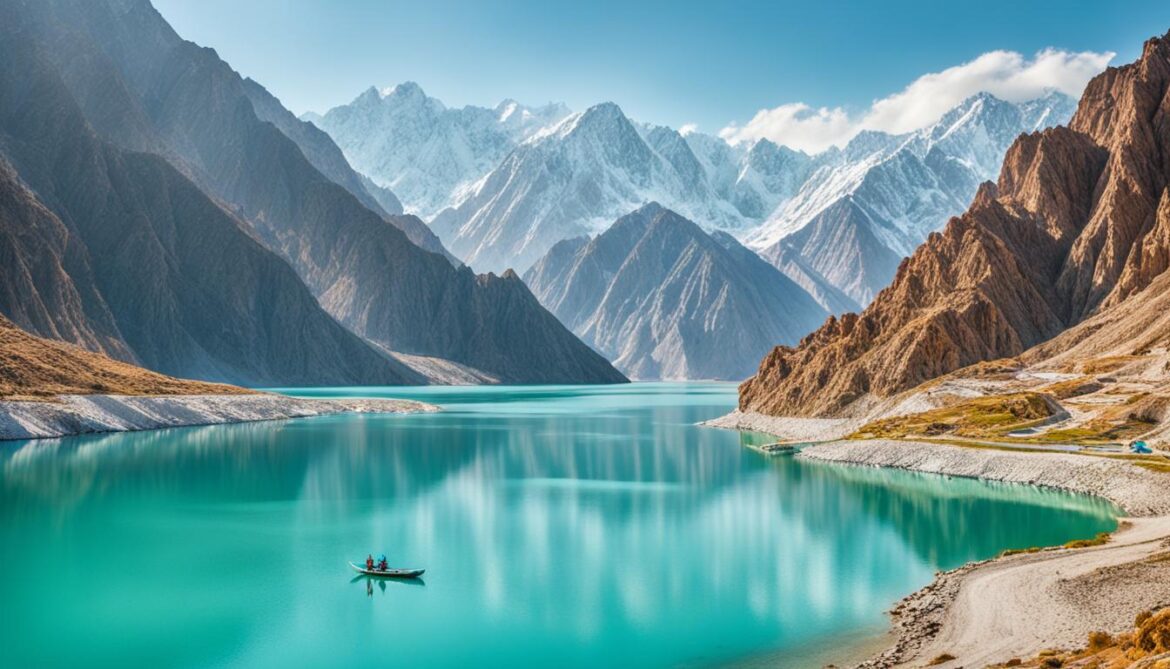
Conclusion
Pakistan is blessed with a wealth of sacred natural sites that hold immense ecological significance and embody a rich cultural heritage. These sites are not only valuable for their biodiversity but also contribute to sustainable development and nature conservation in the country.
The government of Pakistan has taken proactive measures to protect and promote these sites, recognizing their importance in preserving the country’s natural wealth. By prioritizing their conservation, Pakistan ensures the safeguarding of its diverse ecosystems, which in turn supports the sustainable development of local communities.
Moreover, these sacred natural sites provide a gateway for individuals to connect with nature on a deeper level, fostering a sense of appreciation and respect for the natural world. By valuing and preserving these treasures, Pakistan not only preserves its cultural heritage but also creates opportunities for future generations to experience the beauty and ecological significance of these sites.
By integrating the principles of sustainability and environmental stewardship, Pakistan sets an example for other nations to follow. Through the preservation and promotion of its sacred natural sites, Pakistan embraces a holistic approach to development that recognizes the intrinsic value of nature and the need to preserve it for future generations.





